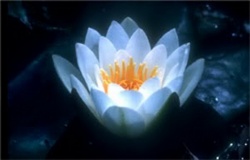Padma
Padma - Central Symbol in Buddhism.
Because the Lotus grows in the mud but blooms untainted above the surface, it symbolizes those who overcome Ignorance and attain Enlightenment.
One of the Eight auspicious symbols of Buddhism The Lotus (Skt. padma; Tib. pad ma):
The Lotus does not grow in Tibet and so Tibetan Art has only stylized versions of it.
Nevertheless, it is one of Buddhisms best recognized motifs since every important deity is associated in some manner with the Lotus, either being seated upon it or holding one in their hands.
The roots of a Lotus are in the mud, the stem grows up through the water, and the heavily scented flower lies above the water, basking in the sunlight.
This pattern of growth signifies the progress of the soul from the primeval mud of materialism, through the waters of experience, and into the bright sunshine of Enlightenment.
Though there are other water plants that bloom above the water, it is only the Lotus which, owing to the strength of its stem, regularly rises eight to twelve inches above the surface.
Thus says the Lalitavistara, the spirit of the best of men is spotless, like the Lotus in the muddy water which does not adhere to it.
According to another scholar, in Esoteric Buddhism, the Heart of the beings is like an unopened Lotus:
when the virtues of The Buddha develop therein, the Lotus blossoms; that is why The Buddha sits on a Lotus bloom.
Significantly, the color of the Lotus too has an important bearing on the symbology associated with it:
1). White Lotus (Skt. pundarika; Tib. pad ma dkar po): This represents the state of Spiritual perfection and total Mental purity (Bodhi).
It is associated with the White Tara and proclaims her perfect nature, a quality which is reinforced by the color of her Body.
2). Red Lotus (Skt. kamala; Tib: pad ma chu skyes):
This signifies the original nature and purity of the Heart (hrdya).
It is the Lotus of Love, Compassion, passion and all other qualities of the Heart.
It is the flower of Avalokiteshvara, the Bodhisattva of Compassion.
3). Blue Lotus (Skt. Utpala; Tib. ut pa la): This is a Symbol of the victory of the spirit over the senses, and signifies the Wisdom of Knowledge.
Not surprisingly, it is the preferred flower of Manjushri, the Bodhisattva of Wisdom.
4). Pink Lotus (Skt. padma; Tib. pad ma dmar po): This the supreme Lotus, generally reserved for the highest deity. Thus naturally it is associated with the Great Buddha himself.
A Lotus; symbolic for the family of Buddhas and divine birth, also symbolizes the female principle or the female genitals.
Buddhists regard the Lotus as a flower of divine origin since it reproduces from its own womb rather than in the soil, and the padma Symbol is sen as a pledge of salvation.
One of the Eight auspicious symbols
The Lotus flower (Sanskrit: Padma), representing primordial purity (Tibetan:
ka dag) of Body, speech, and Mind, floating above the muddy waters of Attachment and Desire; represents the full blossoming of wholesome deeds in blissful Liberation.
